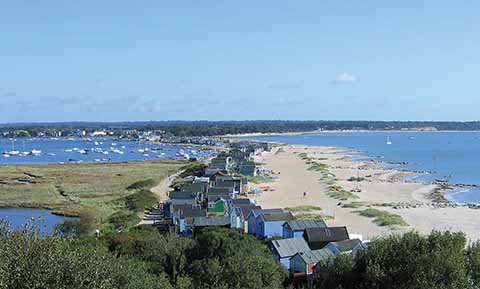Mudeford Sandbank – a place of ships and stars
Bill Hoodless on a sandspit with a rich history and delightful sense of place
Published in August ’19

An original oil painting dated February 1850 by Arthur Stephen Holloway, son of the boat builder George Holloway, some two years after the launch of the Enterprize. Credit: Courtesy of the Ian Stevenson archive
Charlotte, Lady Canning was a most attractive and talented artist who became a Lady of the Bedchamber to Queen Victoria and the wife of the first Viceroy of India. Her father was Lord Stuart de Rothesay, who built Highcliffe Castle over the five years to 1835. So when George Holloway, a boat-builder from the influential and well-known Christchurch family of that name, launched a brig of 193 tons in August 1842, it was appropriate that he named her the Viscountess Canning after the then 25-year-old Charlotte. The brig also carried a handsome gilt figurehead of the lady whose name she bore.
The two-masted square-rigged ship was yellow-bottomed, having a sheath of brass, an anti-fouling method which was just as good as copper but much cheaper. It was reported at the time to be a fine ship and a commercial success for Holloway’s experiment of a new boatyard for bigger ships. To the accompaniment of cheering from over a thousand spectators and the roar of a battery of cannon, the launch was beautiful, majestic and accident-free.
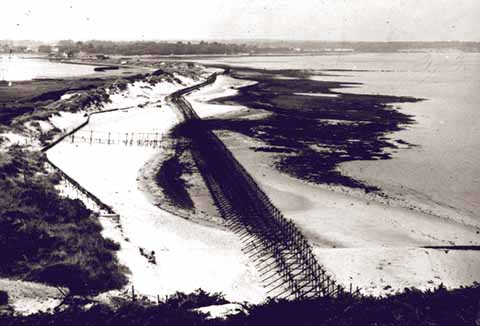
Top: Mudeford Spit as it is today. Bottom: How it looked while the war was on (image courtesy of Hampshire Museums)
Having traded extensively, the brig was wrecked on passage to Yarmouth in 1861, the very same year as the untimely death of Lady Canning of jungle fever in Calcutta, just before a planned return to Britain.
The ships built on Mudeford Sandbank at that time were launched into the waters of the Run just by the Black House (now converted into upmarket holiday flats). Before that time, when the smuggling industry was at its height, the site was probably used for making much smaller vessels, the fast rowing boats with sails known as Guinea cutters that could outpace the ships of the Revenue men in their attempts to confiscate contraband.
Six years after the Viscountess Canning, the Enterprize, at 253 tons the largest ship ever built in Christchurch (cost £328 18s.), was smoothly launched from the same boatyard and again, to great cheering from the assembled onlookers. After trading to the Mediterranean and in British coastal waters, the Enterprize was finally condemned in 1864.
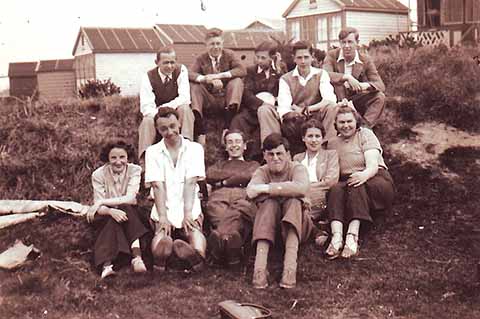
Below A group of friends from the summer of 1939, before the anti-invasion measures took over the sandspit. Credit: Courtesy of Julian White
Moving ahead some 100 years, the Sandbank had long since ceased to be used for commercial ship-building, but it was a place of beauty that was unrivalled for creating fond childhood memories for many people. Among these is June Cooke, ex-Commodore of the Christchurch Sailing Club: ‘My parents, having rented cottages at Sandbanks in Poole for many years, decided that a beach hut at Mudeford seemed like a good idea, especially as they lived nearby in Bournemouth. So in the late 1930s, my father, who was a builder, built two adjacent huts, one for the Cooke family and the other for an aunt and uncle and their family. There was no running water on the beach originally and my mother used to tell the story of buying water from the fishermen at the Run. As the hut was well away, near Hengistbury Head, it was a long trek to carry it. Woe betide anyone who dropped it, as it cost 3d a go.
‘At the beginning of the war, my father sent the carpenter to dismantle the huts as soldiers were already ensconced in the bunks. These were brought from Portsmouth and were originally ships’ bunks. Canvas was laced over a tubular metal frame and a feather bed was put on top. They were so comfortable that, had he not started to take the huts apart, the soldiers would never have moved! The huts were then floated on pontoons to Christchurch and stored for the duration of
the war.
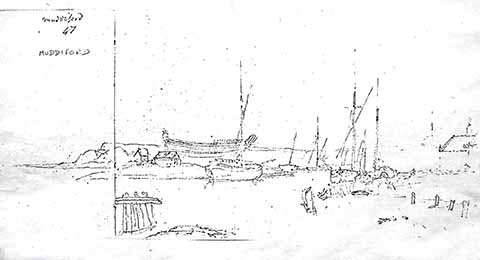
This 1847 sketch of the 253-ton Enterprize when it was still on the stocks, is by Captain Sir Charles Burrard RN. Credit: Courtesy of the Ian Stevenson archive
‘After the war, the huts were returned and placed in a better position high up at the corner of the harbour. There was a pleasant grassy bank near the creek and my friends and I were able to pitch our tents on this spot. We also spent many magic nights sleeping under the stars without tents, watching the sunsets and the dawn breaking. In the spring, the area was carpeted with sea pinks and, later in the year, with sea lavender. One of the group had a small duck punt and we used to supplement our pocket money ferrying passengers across the creek, as there was no bridge at that time.
‘Family walks were often taken before breakfast and I well remember the song of the skylarks as we walked over the headland. The heather seemed so much more colourful then, setting off the stunning views to Studland and Old Harry Rocks.
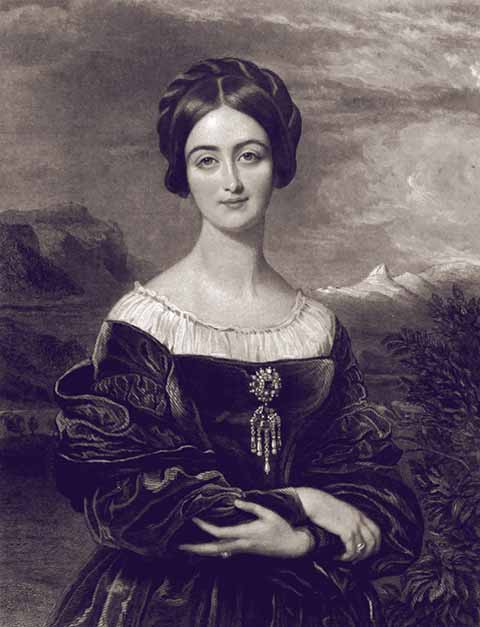
Charlotte, Lady Canning, for whom the 193-ton, Mudeford-built brig Viscountess Canning was named. Credit: Courtesy of the Ian Stevenson archive
‘The lily pond was started off by Mr Brewer, the keeper, who patrolled the area most conscientiously. He always dressed in the estate keeper’s gear and seemed to have eyes in the back of his head. Later, when I owned a sailing dinghy, he reported to my father if he thought I had gone too far out towards the Needles. It seems incredible that his one lily plant has increased to the masses now growing on this pond.
‘We often played on the lower road in the woods. There were fantastically big trees to climb and in the spring the ground was carpeted in the wonderfully scented bluebells. There were also clay slopes which we slid down on tin trays.
‘Car permits were issued infrequently, in order to transport luggage and stores. There was no Noddy train so you always had to walk from the car park at the Double Dykes. The fishermen would row you across the Run in their salmon punts for whatever money you chose to give them, but if the weather was bad or they were ensconced in the pub, you might wait forever.
‘The beach hut, high up on a sand dune, commanded good views of the harbour and was also useful when my mother wanted us for meals, as she waved a flag. I loved to watch the beautiful lizards sliding across the sand; there were many more then.
‘We nearly always went swimming around the big groyne. There was no path, so you jumped from rock to rock in order to get there. The rock pools were fascinating, full of sea anemones of many colours. We also went shrimping with
our nets.
‘Yes, Mudeford Sandbank was indeed a paradise for children and adults.
‘Hopefully, with the guidance of the conservationists, we will restore some of the former natural life and beauty to the area and educate ourselves to preserve our natural heritage.’
